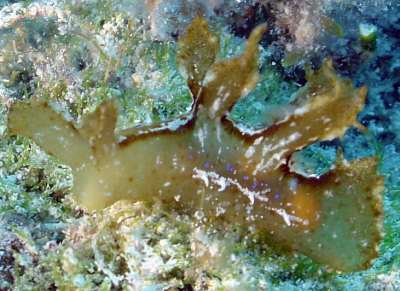
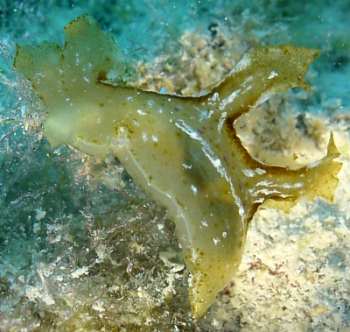
Scyllaea pelagica
Linnaeus, 1758
Order: NUDIBRANCHIA
Suborder: DENDRONOTINA
Family: Scyllaeidae
DISTRIBUTION
Worldwide, living pelagically attached to pieces of floating kelp or Sargassum weed, where they feed on attached hydroids.
PHOTO
Bimini Islands, Bahamas, Western Atlantic. on floating Sargassum weed. February 08, 2004. Size: 40mm. Photos: Marina Poddubetskaia.
The body is dorso-ventrally flattened with large elaborate flattened rhinophore sheaths which dwarf the small rhinophore. There are two pairs of dorso-lateral lobes, which have a characteristically jagged edge, and the posterior end of the body has a flattened medio-dorsal crest which also stands vertically. There are small scattered conical tubercles on the sides of the body and fine dendritic gills over the inner surface of the dorso-lateral lobes and the dorsum. The genital opeming is on the right side in front of the anterior lobe, and the anus lies between the two right lobes. The body is yellowish with brown mottling, and some white markings, and so matches the Sargassum weed on which it lives. There are often a row of brilliant blue spots down each side of the body. It grows up to 45 mm in length.
References:
• Baba, K. 1937. Record of a nudibranch, Scyllaea pelagica Linne from Sagami Bay, Japan. Zoological Magazine, Japan [Dobutsugaku Zasshi] 49,(7): 247-249.
•Baba, K. (1949) Opisthobranchia of Sagami Bay. Iwanami Shoten. Tokyo.
• Cuvier, G.L.C. (1805) Memoire sur la Scyllee, l'Eolide et le Glaucus avec des additions au memoires sur la Tritonie. Annales de Museum National d'Histoire naturelle, Paris, 6: 416-436, Pl 61.
• Hancock, A., & D. Embleton. 1847. On the anatomy of Scyllaea. The Athenaeum (1028): 748.
• Hancock, A., & D. Embleton. 1848. On the anatomy of Scyllaea. Report of the 17th Meeting of the British Association for the Advancement of Science, Oxford, 1846, 17: 77. • Hancock, A., & D. Embleton. 1848b. Sur l'anatomie de la Scyllaea. Journal Universel des Sciences et des Societes Savantes in France et a l'etranger, Sciences Mathematiques, Physiques et Naturelles, Paris, 16(1): 80-81.
• Linnaeus, C. (1758). Systema Naturae, Ed. 10. Vol.1.
• Roginskaya, I. S. 1987a. Food and feeding of Opisthobranchia: Scyllaea pelagica Linne. pp. 43-46, 104, 106. [In:] A. P. Kuznetsov & M. N., Sokolova (Eds.). Feeding of marine invertebrates and its significance in formation of communities. Academy of Sciences of the USSR, P. P. Shirshov Institute of Oceanology, 110 pp. Moscow. [In Russian].
Rudman, W.B., 2004 (March 10) Scyllaea pelagica Linnaeus, 1758. [In] Sea Slug Forum. Australian Museum, Sydney. Available from http://www.seaslugforum.net/find/scylpel
Related messages
Scyllaea pelagica in Miami
April 9, 2010
From: Jonathan Cohen
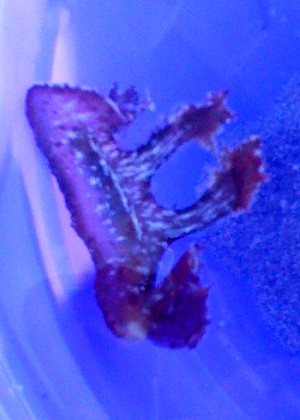
Hello,
Just wanted to share these pictures and video that I took in Sunny Isles Beach Florida near Aventura. We saw this thing swimming in the ocean and caught it in a pail. After contacting Prof. Nancy Voss of the Rosenstiel School at the University of Miami she identified it as "a nudibranch mollusk, possibly Scyllaea pelagica, the sargassum nudibranch".
Here is the link to the video, incredible how this thing swims:
http://www.youtube.com/watch?v=Zr_hePDEklo
Locality: Sunny Isles Beach, 2 feet or 0.5 m , FL, USA, Atlantic Ocean, 03 April 2010. Length: 2.5 inches. Photographer: Jonathan Cohen.
Enjoy,
Jonathan
jcsultan@gmail.com
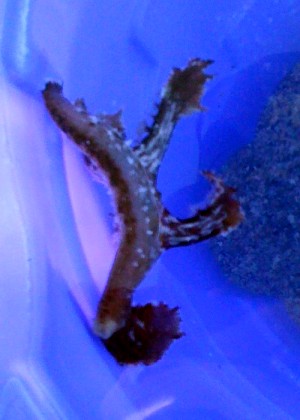
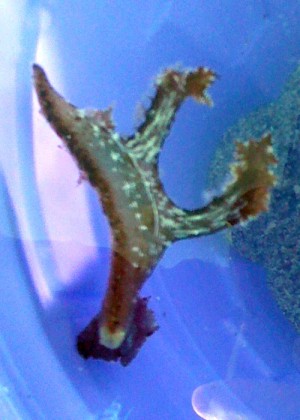
Dear Jonathan,
Thanks for the link to your clip of Scyllaea pelagica swimming. Quitye a few of the group of nudibranchs that Scyllaea belongs to [Dendronotina] swim in a similar manner by lateral flexing of the body. The best example must be Bornella anguilla which has multiple waves running down the body so its swims like an eel - hence the name anguilla which is from the Latin for an eel.
Best wishes,
Bill Rudman
Sargassum sea slugs in Gulf of Mexico [1]
February 22, 2010
From: Denice Drass
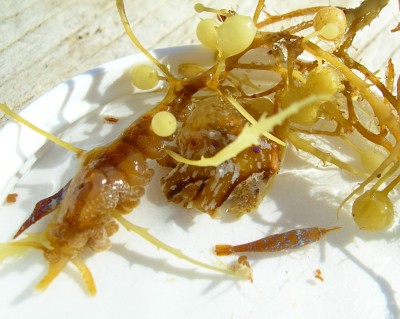
Dr. Rudman,
these specimens were collected in Sargassum with a neuston net offshore off Louisiana in the Gulf of Mexico in February of 2008 at around 5 am. I have wondered about how different they are and was given your website to send the pictures to. I did not measure the specimens, however the diameter of the lid that the specimens are floating in is 90 mm.
Locality: 28.00 N, 90.00 W, offshore of Lousiana, Gulf of Mexico, 09 February 2008, neuston. Photographer: Denice Drass.
Denice Drass
Denice.Drass@noaa.gov
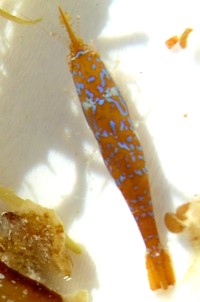
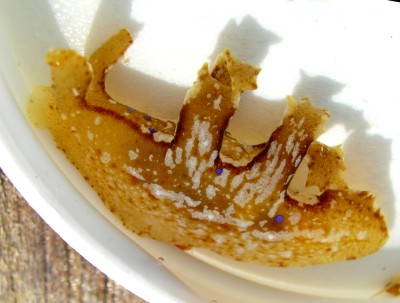
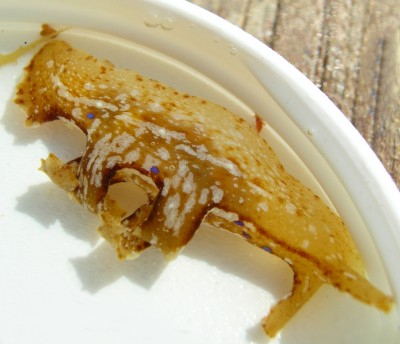
Dear Denice,
In your upper photo I can make out 3 different animals. I assume they are all part of the fascinating assemblage of animals which have made the beds of floating brown algae their special habitat. The brown 'lump' on the left of your photo is an aeolid nudibranch which I will discuss in a separate message [#23257] and the blue-marked orange shrimp at the bottom right could well be one of the Sargassum 'family' but you will need to check with a crustacean expert. The larger slug with two large blue spots on each side is Scyllaea pelagica, and is a well known member of the Sargassum fauna. As you will find in an earlier message [#2066] its unique way of life was reported nearly 200 years ago
Best wishes,
Bill Rudman
Scyllaea pelagica from Nth Carolina
June 15, 2005
From: John McChesney
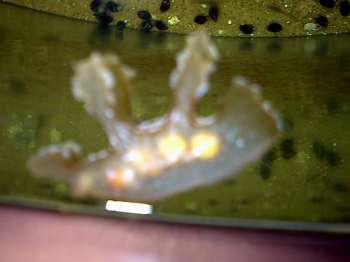
Hello,
I am trying to figure out what type of nudibranch this is..
Locality: Swansboro, North Carolina, USA, Atlantic coast. Depth: 1ft
Length: 3 inch. 12 June 2005. Photographer: John McChesney
John McChesney
CWAquatics@earthlink.net
McChesney, J., 2005 (Jun 15) Scyllaea pelagica from Nth Carolina. [Message in] Sea Slug Forum. Australian Museum, Sydney. Available from http://www.seaslugforum.net/find/14049Dear John,
This is Scyllaea pelagica. Have a look at the Fact Sheet for information on this fascinating nudibranch which mimics the brown algae it is normally found living on.
Best wishes,
Bill Rudman
Re: Scyllaea pelagica from Virgin Ids, Caribbean
May 27, 2005
From: Suzy Hime
Dear Bill,
Many thanks for confirming our identification [message #13679] -- the website is great and I was very excited to find the picture of Scyllaea pelagica which so closely matched my own!
Suzy Hime
suzy@ishime.go-plus.net
Hime, S.E., 2005 (May 27) Re: Scyllaea pelagica from Virgin Ids, Caribbean. [Message in] Sea Slug Forum. Australian Museum, Sydney. Available from http://www.seaslugforum.net/find/13886Scyllaea pelagica from Virgin Ids, Caribbean
May 6, 2005
From: Suzy Hime
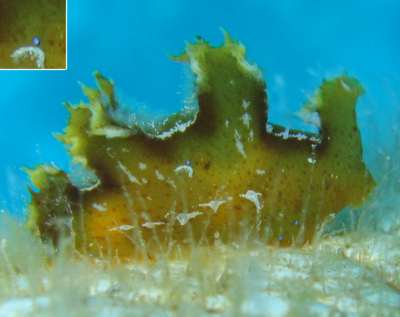
Whilst doing our safety stop on a dive in the British Virgin Islands our dive master spotted this nudibranch on a polystyrene mooring line float in about 17 feet of water. There was a growth of what I believe are small hydroids on the float on which it was presumably feeding. It was in on the wreck of the Fearless which is a 110ft wooden minesweeper which sits upright next to a small coral wall on a sandy bottom and is west of Great Harbor Point, Peter Island
Locality: Wreck of Fearless, Peter Island. British Virgin Islands. Caribbean.
Depth: 17 feet. Length: 20-25 mms (guesstimate). 18 April 2005. Polystyrene float on mooring line over wreck. Photographer: Suzy Hime
I took the attached photo of it and when we tried identifying it from Paul Humann's book Reef Creatures we decided it could only be Scyllaea pelagica - the Sargussum Nudibranch - in spite of the fact there was no Sargasso weed to be seen. I noticed that it has some bright blue spots which were more obvious when I zoomed in on the photo. It looks very like the specimen in your photograph right down to the blue spots, dark edges and white marks. Can you confirm the identification please?
Regards,
Suzy Hime
suzy@ishime.go-plus.net
Hime, S.E., 2005 (May 6) Scyllaea pelagica from Virgin Ids, Caribbean. [Message in] Sea Slug Forum. Australian Museum, Sydney. Available from http://www.seaslugforum.net/find/13679Dear Suzy,
Yes this is Scyllaea pelagica. It is often found on Sargassum and other floating - and sometimes attached - brown algae, but the attraction are the hydroid colonies it feeds on. Its colour pattern, certainly suggests it has evolved to live on brown algae, where it is so well camouflaged, so it does seem rather conspicuous - and unprotected - when found on other floating objects such as white polysterene or plastic floats.
Best wishes,
Bill Rudman
Scyllaea pelagica from Bahamas
March 10, 2004
From: Marina Poddubetskaia


Dear Bill,
Here is a record of Scyllaea pelagica from the Bahamas. As usual, this specimen was found in the floating Sargassum algae.
Date: February 08, 2004
Location: Bimini Islands, Bahamas, Western Atlantic
Site: The Sapona (wreck)
Size: 40mm
Photos: Marina Poddubetskaia - Nembro website
Cordially,
Marina.
nembro@nembro.info
Poddubetskaia, M., 2004 (Mar 10) Scyllaea pelagica from Bahamas. [Message in] Sea Slug Forum. Australian Museum, Sydney. Available from http://www.seaslugforum.net/find/12364Thanks Marina,
Bill Rudman
Scyllaea pelagica in my aquarium
October 17, 2003
From: Manuel Marquez
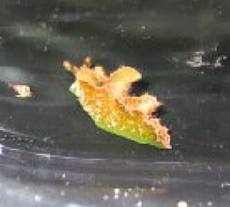
Good Morning
I would just like to send this one again because in my last message I did not put enought information for you. I took a pic of this suspected sea slug, I dont think that its a nudi but not to sure. Are you able to help me with an ID off it and what food do they eat and what type of area are they found? I did not buy it he was in my live rock.
thank you with any help.
Manuel
Adelaide, Australia
dicisco@bigpond.net.au
Marquez, M., 2003 (Oct 17) Scyllaea pelagica in my aquarium. [Message in] Sea Slug Forum. Australian Museum, Sydney. Available from http://www.seaslugforum.net/find/11261Dear Manuel,
As a general rulel, I need some background information, especially when the photo is not too detailed, so I have chance of identifying the animal. Most nudibranchs only live in one part of the world so if I know where the animal in your photo comes from I can make better guess at what it is.
You still haven't told me where the 'live rock' comes from so I guess I still haven't much to go on. I have enlarged your photo a bit and I am pretty sure it is the southern Australian form of Scyllaea pelagica. It is usually found living in the open sea attached to floating kelp and other brown sea weed. It feeds on small hydroids which live of the sea weeds. I don't think it would be very easy to keep in a aquarium as its hydroid food are very difficult to keep alive in captivity
Best wishes
Bill Rudman
Feeding in Scyllaea pelagica
September 10, 2003
From: Irina S. Roginskaya.
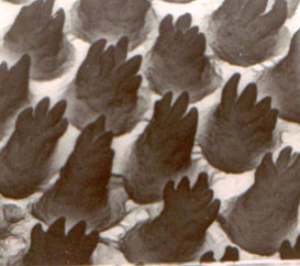
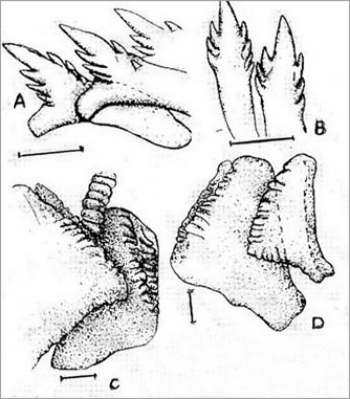
FIGURES: Fig.1. SEM photo of the armature of processus masticatorius. x3000
Fig. 2. A,B.Lateral teeth of the radula of S. pelagica. Scale bar =50 microns. C,D - gastric plates of S. pelagica. Scale bar = 100 microns
Dear Bill,
To my regret I never had seen live Scyllaea pelagica and have only had preserved specimens of these species to study(Roginskaya,1987; Iljin and Roginskaya,1987).
My specific aim has been to better understand the mouth structures and stomach contents of these mollusks. The unusual strengthening of the feeding apparatus of S. pelagica by the development of gastric plates - in addition to the multiseriate radula and strong mandibles [jaws] which have powerful chitinous armature of the 'processus masticatorius' (see fig 1: SEM photo of detail) appeared to me rather unjustified, as this species had been considered by many authors to be a hydroid feeder (Marcus,1961; Thompson & Brown,1976,1981; Thompson, 1980). As far back as 1871, Bergh described companularian hydroids in the gut of S. pelagica from the Sargasso Sea.
When we see similar gastric gizzard plates in certain other Dendronotoidea, e.g. in the hind stomach of Marionia, which feeds on hard Alcyonaria, packed with calcareous spicules - this seems quite natural. But what is the advantage of such a complicated alimentary apparatus in S. pelagica which feeds on relatively 'soft' hydroids attached to floating Sargassum weeds?
The material for examination included 25 specimens of S. pelagica - preserved in alcohol - from four sampling sites.
• 1. Seychelles, 10 Dec. 1964; R/V "Vytiaz", cruise 36,sublittoral, depth 1m , one specimen, size 17.0mm.
• 2. Central part of the Gulf of Mexico, 03-05 April 1973; R/V "Akademic Kurchatov" , cruise 14, surface sampling , biocoenosis of floating Sargassum.Two specimens ,size 15.5 and 11.5 mm.
• 3. Sulawesi Sea, near Mindanao Is, 26-27 Febr.1975; R/V "Vytiaz", cruise 57, biocoenosis of floating Sargassum, one specimen,size 10.2mm.
• 4. 33 55'N, 29 16'W, 22 Oct.1981; R/V "Akademic Petrovsky", from the fouling of the bouy, captured in the ocean. 21 specimens, size from 3.2 to 9.0mm.
Unfortunately the stomach of the specimens from the sampling sites no.1 and no.2 proved to be completely empty.The gut contents of the specimen from the sample site no.3 and of five specimens examined from the sample site no.4 [body length: 3.4mm, 4.6mm, 5.3mm, 6.0mm and 9.0mm] were swollen from the accumulation of large bundles of branches of thecate hydroids. (In sample site no.4 - Laomedea dichotoma Vervoort, 1959). And moreover in the stomach of the specimen from sampling site no.3, among the whisks of hydroid branches there was the semi-digested buccal bulb of a juvenile example of the nudibranch Fiona pinnata. Its radular ribbon was in good condition, but the jaw plates were cracked.
The character of the gut contents of these six specimens differed from this of the common littoral hydroid feeders, e.g. the common White Sea Flabellina verrucosa. The food lump in the stomach of Flabellina contains only separate empty hydrothecas in an amorphous substance. I often observed the feeding process of White Sea F. verrucosa on Obelia longissima - how it gravely, methodically, never in a hurry, cuts off from the colony the separate polyps in hydrothecas, leaving the naked hard branches behind. Perhaps this measured behaviour is not suitable in the mobile surrounding of floating weeds, where S. pelagica is forced to hurry engulfing their food object, in case it slips off through wave action? Perhaps that is why it seizes indiscriminately the bundles of hydroid branches, sometimes with small Fiona pinnata as by-catch. The strongly cuticularized folds of the stomach, as well as the well-developed gastric plates most probably represent a modification, functionally connected with the forced swallowing of large hard food fragments. And it is in the hind stomach that the main mechanical cultivation [grinding] of the food is realized. Often fragments of hydroid branches were seen between the gastric plates [see fig.2C]. The discovery of large bundles of thecate hydroid branches in the stomach of several S. pelagica from different geographoc regions [eg: Sulawesi Sea and Atlantic Ocean] indicates that this feeding behaviour is not accidental for this species.
References:
• Bergh,R.1871.Beitrage zur Kenntniss der Mollusken des Sargassomeeres. Verh.d.K.K.Zool. bot.Gesell.Wien.Band 21: 1273-1308.
• Iljin,I.N. & Roginskaya,I.S. 1987. Nudibranchia, Mollusca. In Pelagic epifauna on solid substrates. pp.72-75 In: A.P.Kuznetsov & M.N.Sokolova [eds]. Feeding of marine invertebrates and its significance in the formation of communities. Academy of Sciences of the USSR, P.P.Shirshov Institute of Oceanology, Moscow. [in Russian , with nglish summary].
• Marcus, Ernst. 1961. Opisthobranchia from North Carolina. Journ. Elisha Mitchell Scient. Soc., 77: 141-151.
• Roginskaya, I.S. 1987. Food and feeding of Opisthobranchia: Scyllaea pelagica Linne. pp.43-46/ In: A.P.Kuznetsov & M.N.Sokolova [eds]. Feeding of marine invertebrates and its significance in the formation of communities. Academy of Science of the USSR, P.P. Shirshov Institute of Oceanology, Moscow. [In Russian, with English summary].
• Thompson, T.E. 1980. World species of the Nudibranch family Scyllaeidae. Haliotis, 10(2}: 182.
• Thompson, T.E. & Brown, G.H. 1976. British Opisthobranch Molluscs. Synopses of the British Fauna (New Series). The Linnean Society of London. Academic Press. 203pp.
• Thompson, T.E. & Brown, G.H. 1981. Biology and relationship of the nudibranch mollusc Notobryon wardi in South Africa, with a review of the Scyllaeidae. J. Zool. Soc. Lond.,194: pp.437-444.
Irina S. Roginskaya.
irina7@hotmail.com
Roginskaya.. I.R., 2003 (Sep 10) Feeding in Scyllaea pelagica. [Message in] Sea Slug Forum. Australian Museum, Sydney. Available from http://www.seaslugforum.net/find/10819Dear Irina,
Thanks for these interesting observations on the stomach contents of Scyllaea pelagica. I agree that the remains suggest that this animal is not such a delicate feeder as many aeolids. However since all dendronotoideans have thickened plates or chitinous thickenings in the posterior part of the stomach, then we must assume that this character evolved to meet the needs of the 'common ancestor' to the tritoniids, scyllaeids, bornellids etc. Perhaps they did evolve from an aeolid-like 'proto-bornella' or 'proto-scyllaea' but it seems strange to me that the common ancestor would have had such unique and specialised habits as modern Scyllaea. Most dendronotoideans are benthic feeders on various cnidarians. I would have thought that it was more likely that their common ancestor was also a benthic feeder, and that stomach plates evolved amongst benthic feeders rather than as a reponse to the needs of one pelagic exception. I could of course be quite wrong, so anyone is welcome to join this discussion
Best wishes,
Bill Rudman
Scyllaea pelagica new problem
June 30, 2003
From: Ron Velarde
Hi Bill,
I just noticed that the Fact Sheet lists Scyllaea pelagica with Linnaeus, 1758 in parenthesis. If Linnaeus erected the genus with S. pelagica as the type species, no parenthesis is needed.
P.S. You don't need to post this unless there is more to the story; just pointing out a correction.
Ron Velarde
rvelarde@sandiego.gov
Velarde, R., 2003 (Jun 30) Scyllaea pelagica new problem. [Message in] Sea Slug Forum. Australian Museum, Sydney. Available from http://www.seaslugforum.net/find/10348Thanks Ron,
I am very grateful for any errors being brought to my attention. You are of course quite right - we only put an author's name in parenthesis [= brackets, (..)] when the genus name is no longer the one the author originally used. I have removed them from the Fact Sheet. I am often asked why brackets are sometimes used and sometimes not, so by posting your message a few more may learn another mystery from the arcane art of zoological nomenclature.
Cheers,
Bill Rudman
Re: Authorship of Scyllaeidae
June 28, 2003
From: Henk K. Mienis
Dear Gert and Bill,
Here my two cents in the Scyllaeidae problem. Although Linnaeus created the genus Scyllaea, he was not the author of the family Scyllaeidae. Bill offered Bergh, 1890, however, the family had been used 35 years earlier by Alder & Hancock in their well-known book concerning the British Nudibranchs.
• Alder, J. & Hancock, A., 1845-1855. A monograph of the British Nudibranchiate mollusca: with figures of all the species. (published in seven parts)
They treat the genus Scyllaea in part 4 (1848). They stated among others that: "Here, however, the typical character of the Tritoniadae is still sufficiently preserved to allow of our retaining the genus in that family." And a little bit further on: "This is the only nudibranchiate mollusk in which any armature of the stomach, performing the functions of a gizard, has been detected."
In the Appendix to part 7 (1855) the family name Scyllaeidae is mentioned on page XX with the only species Scyllaea pelagica Linnaeus, 1758 included.
I do not have access to Rafinesque 1815, so I can not check whether Abbott was correct in considering the latter as the author of the family name Scyllaeidae.
Best regards,
Henk K. Mienis
mienis@netzer.org.il
Mienis, H.K., 2003 (Jun 28) Re: Authorship of Scyllaeidae. [Message in] Sea Slug Forum. Australian Museum, Sydney. Available from http://www.seaslugforum.net/find/10318Thanks Henk,
I must admit I checked Alder & Hancock but stopped at the Appendix because I thought it was just odd notes on species that they had previously dealt with. The index accompanying the Monograph does not include Scyllaeidae, although other family names are included. I should have known it doesn't pay in nomenclatural problems to 'suppose' anything. Since my earlier message I've checked Rafinesque 1815 and he lists Scyllaea as a cephalopod in Family Pleuropteria, SubFamily Pleuropia. So unless someone has an earlier find, Alder & Hancock 1855 seems to be the earliest usage.
• Alder, J., & A. Hancock. 1855. A monograph of the British nudibranchiate Mollusca: with figures of all the species. Part 7. Ray Society, London.
• Rafinesque, C. S. 1815. Analyse de la nature ou tableau de l'univers et des corps organises, pp. 136-149. Palermo.
Cheers,
Bill Rudman
Authorship of Scyllaeidae?
June 21, 2003
From: Gert Lindner
Please, which is the right authorship for the family Scyllaeidae?
I find:
Scyllaeidae LINNAEUS 1758 (Sabelli, Gianuzzi-Savelli & Bedulli)
Scyllaeidae Rafinesque 1815 (Abbott)
Scyllaeidae ALDER & HANCOCK 1855 (Internet)
Scyllaeidae ALDER & HANCOCK ?1864, Bergh 1892
Thank you,
Gert
gert.lindner@T-ONLINE.DE
Lindner, G., 2003 (Jun 21) Authorship of Scyllaeidae?. [Message in] Sea Slug Forum. Australian Museum, Sydney. Available from http://www.seaslugforum.net/find/10278Dear Gert,
It's sometimes not easy to find this information. This earliest use I can find is
Bergh, L. S. R. 1890. Die cladohepatischen Nudibranchien. Zoologische Jahrbucher, Abtheilung fur Systematik Geographie und Biologie der Thiere, 5: 1-75.
Alder & Hancock placed Scyllaea in the family Tritoniidae. If anyone has an earlier use - which they can confirm by actually looking at the publication I would be interested.
Best wishes
Bill Rudman
Feeding in Scyllaea pelagica
October 21, 2002
From: Jason P. Turner
Dr. Rudman,
I am a graduate student at Texas A&M University at Galveston investigating trophic interaction within Sargassum communities in the western Gulf of Mexico. I was wondering if you could help me with some references related to feeding preferences in Scyllaea pelagica. The only citation I can find is by Fine 1970 who describes a paper by Hentschel (1922) who notes that hydroids were not an important component in their food based upon a lack of them upon examination of the gut. I saw on your Forum the discussion on their mouth structures dictating carnivorous feeding, however, do you have any references I could track down which outlines their feeding preferences. Thanks again and I enjoyed the forum and the wonderful pictures.
Thanks, and any information you could offer would be helpful.
• Fine, M.L. 1970. Faunal variation on pelagic Sargassum. Marine Biology, 7: 112-122.
• Hentschel, E. 1922. Mitt. zool. Mus. Hamb. 38: 1-26
Jason Turner
Texas A&M University - Galveston
Fisheries Ecology Research Laboratory Galveston, Texas
turnerj@tamug.tamu.edu
Turner, J.P., 2002 (Oct 21) Feeding in Scyllaea pelagica. [Message in] Sea Slug Forum. Australian Museum, Sydney. Available from http://www.seaslugforum.net/find/8235Dear Jason,
You raise an interesting point - when you burrow into the literature you find that some information is either not very soundly based - or may be based on personal observations which were never published. I have always assumed Scyllaea was a hydroid feeder and Thompson & Brown (1981) state that it 'feeds upon hydroids attached to [floating oceanic] algae'. However they cite no references and after a quick look through references I have on the species I can find no reference to any feeding infomation. That is not to say it doesn't feed on hydroids, its just I don't know who has actually observed it doing so. It is possible someone can help with a reference or observations
Best wishes
Bill Rudman
Scyllaea pelagica from Turkey
October 3, 2002
From: Baki Yokes
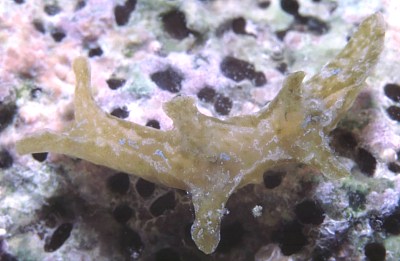
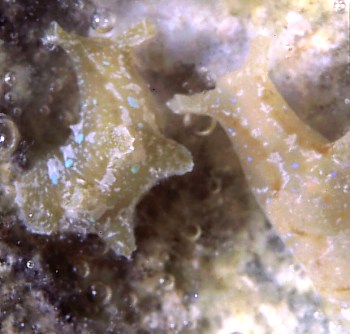
Dear Bill,
Here are two photos of a species that I couldn't identify. We have found a group of this slug, about 20 specimen, on a very shallow rock surface. Their sizes were ranging between 0,5-2.5cm. The blue spots on their surface were glowing like neon lights. Can you identify this species?
Date: August 11, 2002
Place: Antalya, Turkey
Divesite: Kekova Island
Depth: 0.3-0.5m
Size: Approx. 2cm
Photos: Baki Yokes
Thank you & best regards
Baki
bakiyokes@turk.net
Yokes, B., 2002 (Oct 3) Scyllaea pelagica from Turkey. [Message in] Sea Slug Forum. Australian Museum, Sydney. Available from http://www.seaslugforum.net/find/8007Dear Baki,
I assume this is Scyllaea pelagica, which to my knowledge is the only member of the Scyllaeidae recorded from the Mediterranean. Normally this species, as its name 'pelagica' suggests, is found on drift algae, so it may be worth checking whether these bottom-dwelling animals are really the same. See the other message I am posting today of the same species from the Adriatic.
Best wishes,
Bill Rudman
Scyllaea pelagica from Brac Island, Adriatic sea
October 3, 2002
From: Adam Petrusek
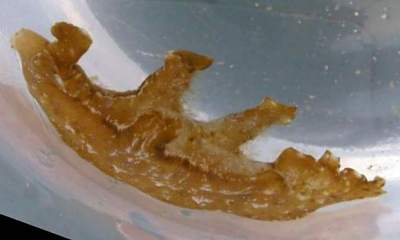
Dear Dr. Rudman,
I would like to find out what this amazing "seasnail" is.
The length of the animal was about 6 cm and it was caught on September 9th near Sumartin, island Brac, Croatia, Adriatic sea. It was either hauled with a seaweed from the depth of 25-30 m or swept to the shore with a seaweed. (We do not exactly know as it was actually found while cleaning some sampling equipment at the shore. The UW photo was taken while releasing this individual.)
We could not see any remainders of the shell. The numerous "polyp-like" white protubernaces on the dorsal side of the animal were quite distinct.
Thank you very much for your help.
Sincerely
Aadm Petrusek
Department of Hydrobiology,
Charles Univerisy, Prague
petrusek@cesnet.cz
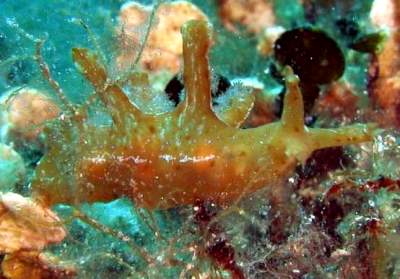
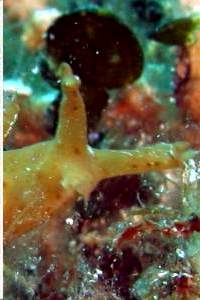
Thanks Adam,
I have posted another message about the same slug recently found in Turkey. It is Scyllaea pelagica which is normally found living on drift brown algae in the open sea. It feeds on hydroids growing on the algae. I would guess that your animal probably carried ashore on a clump of algae. However Baki Yokes, in his message about the Turkish animals, reports that the animal were crawling on the sea bottom, which raises the possibility that in the Mediteranean region there is a non-'pelagic' form of the species.
Best wishes,
Bill Rudman
Radula of Scyllaea pelagica
September 14, 2002
From: Bill Rudman
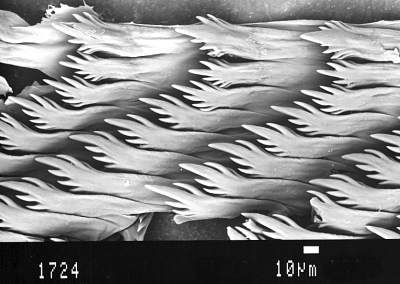
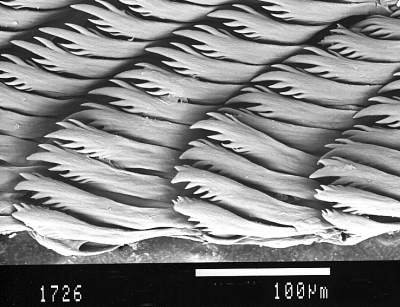
Here are some SEM photos of the radula of Scyllaea pelagica.
PHOTOS: Townsville, Queensland, Australia, February 1975. AM C99298. Upper photo showing central tooth and inner teeth on right side of ribbon. The radular ribbon is torn in the photo. Normally there is no gap between the central tooth and the teeth on the left side of the ribbon. Lower photo showing outer teeth on right side. Photos: Geoff Avern.
Scyllaea pelagica, like Crosslandia viridis, has a central radular tooth, closely flanked on each side by lateral teeth. Notobryon wardi on the otherhand, lacks a central tooth.
Bill Rudman
Rudman, W.B., 2002 (Sep 14) Radula of Scyllaea pelagica. [Message in] Sea Slug Forum. Australian Museum, Sydney. Available from http://www.seaslugforum.net/find/7939Thanks for identifying Scyllaea pelagica
June 13, 2002
From: Carrie O'Sullivan
Bill:
Thank you so much for your help identifying the sea slug, Scyllaea pelagica. I can't wait to get home & share your answer and the web site with my daughter. She's already hooked - we checked out all the available books on sea slugs from the library yesterday. We've learned a lot about sea slugs, but with so many incredibly beautiful creatures to photograph, we couldn't find any pictures of our little guys. She is going to be ecstactic to see all the info here on your site. It is so wonderful to find a website like this!
Carrie
co'sullivan@weingarten.com
O'Sullivan. C., 2002 (Jun 13) Thanks for identifying Scyllaea pelagica. [Message in] Sea Slug Forum. Australian Museum, Sydney. Available from http://www.seaslugforum.net/find/7233Slug? in Sargasso sea weed
June 12, 2002
From: Carrie O'Sullivan
I am just a mom with a child who is incredibly curious about nature. We were looking for creatures in Sargasso sea weed which was washing up at Galveston Island, Texas last week. We think some of the creatures we found were some kind of nudibranch. They were about 1 inch long and were colored yellow-orchre and light brown with bright blue flecks on them. They had several wavy appendages along the bottom side of their bodies. Would you know if these are some kind of sea slug?
Thanks for your help,
Carrie O'Sullivan
co'sullivan@weingarten.com
O'Sullivan, C., 2002 (Jun 12) Slug? in Sargasso sea weed . [Message in] Sea Slug Forum. Australian Museum, Sydney. Available from http://www.seaslugforum.net/find/7205Dear Carrie,
Surely not 'just a mom' - I think it was Ghandi who said if you teach a man you teach one person but if you teach a mother you teach a family.
Your animal is almost certainly the nudibranch Scyllaea pelagica which is only found living amongst floating brown sea weeds. If you look at the other messages on this page you will find three with beautiful photos by Anne DuPont of this fascinating species.
Best wishes,
Bill Rudman
Re: Seaweed creature from Texas
June 3, 2001
From: Alan Titus
Dear Bill,
Thank you for your help.
Alan
atitus@dupriestandsons.com
Titus, A., 2001 (Jun 3) Re: Seaweed creature from Texas. [Message in] Sea Slug Forum. Australian Museum, Sydney. Available from http://www.seaslugforum.net/find/4486Seaweed Creature
June 1, 2001
From: A Titus
Spent the weekend on the Texas Coast. A slug type animal was in the seaweed by the hundreds. It was around 2" long and had an appearance of the sea-weed itself. Just curious if anyone know what this is called and if a picture is available.
A. Titus
atitus@dupriestandsons.com
Titus, A., 2001 (Jun 1) Seaweed Creature. [Message in] Sea Slug Forum. Australian Museum, Sydney. Available from http://www.seaslugforum.net/find/4469Dear Mr Titus,
A seaweed-looking slug in Texas makes me think of Scyllaea pelagica. Have a look at the photos above your message and at the many more photos in the messages below yours on this page and let me know if this is what you found. If so, it seems to make regular visits to Florida and Texas. It lives on the brown floating kelp, eating the small hydroid colonies which live on the seaweed. At some times of the year the winds and currents strand the kelp on the shore. Basically the slug has no say in where it ends up.
Best wishes,
Bill Rudman
Re: Slug on seaweed
May 23, 2000
From: Jamin Bortz
Dear Bill,
I was excited to see your reply on my email. Thank you for taking the time out of your schedule.
Well the slug you suggested is in fact the critter that I stumbled across, I am glad that the algae I.D. helped. I had a feeling it would since the slug looks just like it. I am sad to say that I am unable to find the slug in my tank. I collected several shrimp and three large crabs. I assumed since they all looked like the sargassum that they shared a symbiotic relationship. I guess I was wrong or he is really blending in with the algae. I suppose he was doomed since I only had limited sargassum to supply him with hydroids. I don't feel terribly bad since it was a matter of hours before he would have been on the beach tanning. I would not have collected him otherwise.
Anyway, thanks for your input I love the internet's ability to provide services like this.
Jamin
JBortz6469@aol.com
Bortz, J., 2000 (May 23) Re: Slug on seaweed. [Message in] Sea Slug Forum. Australian Museum, Sydney. Available from http://www.seaslugforum.net/find/2436Sea slug/ sea hare in seaweed
May 21, 2000
From: Jamin Bortz
I was in Galveston, Texas collecting critters from some floating Seaweed when I came across what I call a sea slug. The papers said that all of the seaweed on the beach (tons) was from Bermuda! I guess they had a storm or something. Anyway, the Seaweed is golden brown, it has 1/2 inch leaves with jagged edges, it also has air bladders in the growth structure. It is very firm almost plastic looking alot like what you would see in a pet stores fake plant section. I was collecting shrimp and crabs that matched the seaweed perfectly. The seaweed also has round spots that are small and random, reddish in nature. The shrimp matched the pattern perfectly. The reason for the discription of the algae is that I also found a slug. It is the same color as the seaweed translucent with no shell and can swim with this really cool motion. It has these long thick rabbit ear looking frilly things on the top of its head as well as the back, It is I believe camouflaged to match with the algae. Really neat stuff kinda ugly coloring though. I took a clump of the algae for possible food. Is this enough info to id. could the algae be food, and are sea slugs poisonous.
thanks
Jamin
jbortz6469@aol.com
Bortz, J., 2000 (May 21) Sea slug/ sea hare in seaweed. [Message in] Sea Slug Forum. Australian Museum, Sydney. Available from http://www.seaslugforum.net/find/2425Dear Jamin,
Your excellent description of the algae was a good way to identify the slug. Your algae is almost certainly Sargassum, a brown algae which can live floating in the sea and at the entrance to the Caribbean where the currents form giant eddies great 'beds' of floating algae occur in a region called the Sargasso Sea. Amazing animals, as you have described, have evolved to live on or amongst the floating beds of sea weed and by taking on the colour and shape of the algae they are well camouflaged from predators.
The slug you have found is almost certainly Scyllaea pelagica which spends its whole life (except when it is a free-swimming larva), attached to floating seaweed. I have put your message on the Scyllaea pelagica Page. If you have a look above and below your message you will find information, and other messages about this animal. You will also find many beautiful photos, some on the sargassum weed, taken by Anne Dupont in Florida.
To answer your questions. As far as I know they are not poisonous.
They use the algae for a home, not as food. What they eat are hydroids which also live on the algae. Have a look at the hydroid page for some information on what they are.
I hope this answers your questions. Let me know if your animals match the photos ... and again I am very impressed with your description of the algae.
Best wishes,
Bill Rudman.
Scyllaea pelagica from Florida
March 9, 2000
From: Anne DuPont
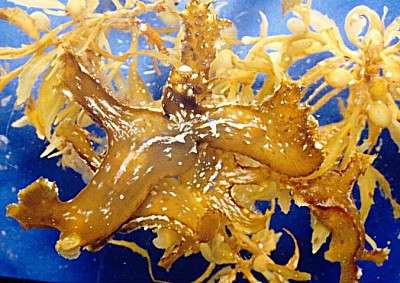
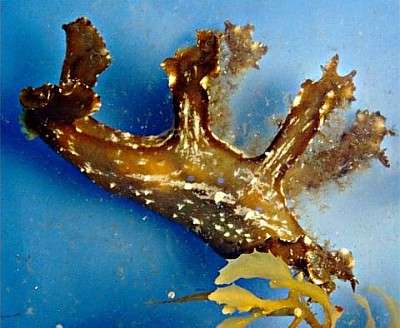
Hello Bill,
Hope all is going well with you.
A few weeks ago off Boca Raton, Florida, a fellow brancher found 5 Scyllaea pelagica on one large clump of Sargassum weed. One was a clear baby about 1/4 inch long, 2 were about 1 inch, 2 were about 2 inches and one little critter was almost 3 inches long!
They were all covered with hydroids (except for the baby). This is the first time I have seen them covered with hydroids and these
were the largest I've ever photographed. I'm sending you several photos. Let me know if you would like to see more.
Lower photo: This was the largest..it was about 3 inches long, February 20, Boca Raton, Florida.
Cordially,
Anne DuPont
adupont@gate.net
adupont@gate.net
Dupont, A., 2000 (Mar 9) Scyllaea pelagica from Florida. [Message in] Sea Slug Forum. Australian Museum, Sydney. Available from http://www.seaslugforum.net/find/2065dear Anne,
Thanks for the great photos. I have put the hydroid photos in second message so I can easily display 4 of your photos.
Scyllaea is a very rare visitor down here so I feel I have learn't as much or more about this animal's shape and external features from your photos, than I have from books.
Best wishes,
Bill Rudman.
Hydroids? on Scyllaea pelagica
March 9, 2000
From: Anne DuPont
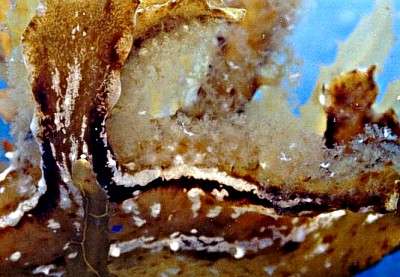
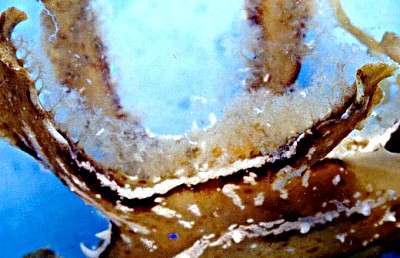
Dear Bill,
Here are some close-up photos of the animals showing hydroids on critter about 2 inches long, February 20, Boca Raton, Florida
Best wishes,
Anne DuPont
adupont@gate.net
DuPont, A., 2000 (Mar 9) Hydroids? on Scyllaea pelagica. [Message in] Sea Slug Forum. Australian Museum, Sydney. Available from http://www.seaslugforum.net/find/2066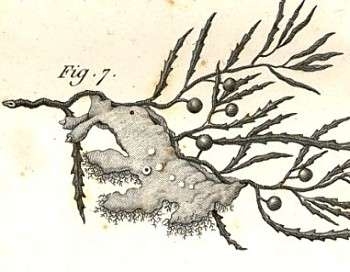
Dear Anne,
What wonderful shots! They certainly look like hydroids but are in fact little papillae on the skin of the slug which function as gills. They are microscopic versions of the gills found in tritoniids such as Tritonia incerta.
Usually the gills aren't very obvious, because the animals we have to look at are half dead. Interestingly the great French naturalist Baron Cuvier illustrated these 'gills' almost 200 years ago, in a very detailed line drawing, which I copy here.
Best wishes,
Bill Rudman.
Reference:
Cuvier, G.L.C. (1805) Memoire sur la Scyllee, l'Eolide et le Glaucus avec des additions au memoires sur la Tritonie. Annales de Museum National d'Histoire naturelle, Paris, 6: 416-436, Pl 61.
Scyllaea pelagica from Florida
December 24, 1999
From: Anne DuPont
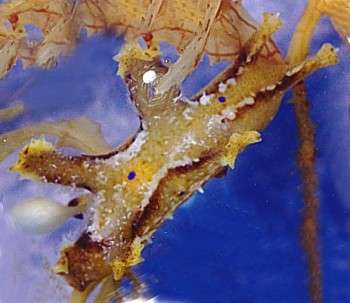
Hi Bill,
Just wanted to share with you this Sargassum nudibranch I photographed yesterday. This time of the year we find these little critters floating in the sargassum weed. He was about 3/4 inches long. Do you know what the "white stuff" is on him? I could not see it with the naked eye. Photo taken Boca Raton, Florida, Dec. 21, 1999 .
Happy Holidays,
Anne
adupont@gate.net
DuPont, A., 1999 (Dec 24) Scyllaea pelagica from Florida. [Message in] Sea Slug Forum. Australian Museum, Sydney. Available from http://www.seaslugforum.net/find/1710Dear Anne,
Thanks for the photo. I think the white bands and streaks alongside the dark brown is just part of the colour pattern. I have seen larger specimens of Melibe with white patches, although smaller animals don't seem to have them.
However the fine white 'hairs' you can see on the inside of the parapodial flaps and on its back behind the second blue spot are fine, sometimes branched, papillae normally considered to be secondary gills.
Best wishes,
Bill Rudman.
More on Scyllaea photos
November 29, 1998
From: Jim Needham
Dear Bill,
Again I want to thank you for your interest and time.
More info:
In image "nudi-5" although it is just visible, there is a light blue spot just above, to the right in the pix, and about half way along the line of "white elongated
spots". Also there are some brownish spots above the white spots. These brown spots were, at times, a very intense, bright, light blue. They stood out more than the white. Also the tips or spikes on the cerata, the protrusions on each side of the top back ??, were at times an intense white.
I looked at the pix that you referenced, http://siolibrary.ucsd.edu/slugsite/pan/pelagica.html. and although similar in form, I never noted any transparentness in the 6 that I had. Would this indicate a different species ? Or a different adaptation ?
I have also seen a couple of other pixs which referenced this critter, but looked nothing like these. I guess it is like you said, "What one person calls 'x'. another person will call 'y'. It is unfortunate that I do not have a good camera, the one I used was barrowed and was one of those point and click automatic things, don't even know the make.
Another observation:
Quite often, I would find these guys on the sides of the refugia that I had them in. It did have a brown algae on it. I was hoping that they were feeding, but I guess not.
Also:
I failed to mention that the pix posting to check.com, as well as the digitizing, was done by my friend. His name is Ron Cadby, owner of http://www.check.com. He is a "web presence provider" It was his camera also. I am in a quandary as to the appropriatness/method of giving him credit for his efforts in this endeavor. I would like to, but I will leave that up to your expetise.
And:
In reference to Hydroids:
Could you point me to some more references, on line if possible. I am thinking of trying to establish a species specific tank for these nudis. I am new to aquaria and have little to zero background in zoo, bio or chem, my background is ee & me. Also art.
Again, thank you for your time.
Jim
P.S. I am thinking of send e-mail to Dee Owens, the person who asked the original question about these guys, it was dated 21 Mar, 98. Just incase they had given up on your site. March to November is a long time..... Is that OK by you ?
jimage@ucnsb.net
Needham, J., 1998 (Nov 29) More on Scyllaea photos. [Message in] Sea Slug Forum. Australian Museum, Sydney. Available from http://www.seaslugforum.net/find/338Dear Jim,
Thanks for the further information. I thought I could see a trace of blue in one of your photos. I remember reading somewhere that it has blue markings as you describe. The other differences in colour between your specimen and the photo I linked to probably represent intraspecific variation. Often there can be a range in a species between those with heavy skin pigmentation and those with very sparse pigmentation and so a translucent - transparent appearance.
I think leaving in your mention of Ron Cadby is probably the best way to acknowledge his help. Concerning information on growing hydroids. I'm afraid apart from suggesting a continuous running seawater system I can't really help. There are a lot of sites for aquarium care and maintenance etc on the web. I don't search them often but I'm sure if you use one of the main search engines you should soon see if there is something relevant on the site.
Your last question: can you contact Dee Owens? Of course you can. That is the whole point of the Sea Slug Forum..to provide information and to provide a point of contact between people with similar interests. My understanding is that most people who send messages to the Forum get useful direct correspondence from other readers / participants. All I ask is that if any interesting information arises from this "behind the scenes" chatting, you let us all know.
Best wishes,
Bill Rudman.
Re: Scyllaea photos
November 27, 1998
From: Jim Needham
Dear Bill,
Yes, you have my permission to use the pixs and links for any enterprise that you deem would further the dissemination of such information advantagous for educational purposes. That is in the spirit of the original concept of the net, back when it was
called the ARPAnet.
I would be very interested in learning about any experiences in keeping these critters alive. I believe that their demise in my system was due to starvation. As the Sargassum died off, I would guess that the hydroid population did likewise. Info on the cultivation and propagation of such would be helpful.
Do you know if Dee's research, or anyone elses, has been fruitful on these guys ?
Thankyou for your time and interest.
Happy Holidays
Jim Needham
904-427-5706
jimage@ucnsb.net
Needham, J., 1998 (Nov 27) Re: Scyllaea photos. [Message in] Sea Slug Forum. Australian Museum, Sydney. Available from http://www.seaslugforum.net/find/334Thanks Jim,
I share your sentiments about the web. Concerning keeping your beasts alive, I think you have set yourself a difficult task. For one, hydroid colonies are difficult to keep alive in artifical conditions, partly because they need a continuous supply of healthy zooplankton to feed on, and partly because their delicate bodies have little protection from changes in salinity, presence of nasty chemicals etc.
Secondly algae, and in particular brown algae, are not good in aquaria because they produce many toxic chemicals both as metabolic byproducts and as a defensive strategy against herbivores. A forgotten piece of brown algae left in a tank or aquarium overnight can kill everything.
I would also be interested in any work that anyone is doing on these animals.
Thanks again,
Bill Rudman.
Re: Sargassum sea slug
November 26, 1998
From: Jim Needham

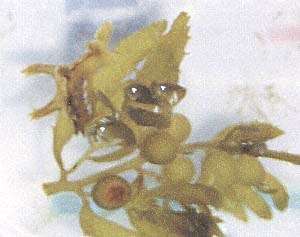
On 18 Oct 98, I collected some critters identified by both Dr. Craig Bingman and Dr. Kerry Clark. Dr. Clark, kclark@fit.edu, is at the Florida Institute of Technology in Melbourne, FL. The Id is Scyllea pelagica. e-mail from Dr. Clark as follows:
"Scyllea pelagica, dendronotacean nudibranch, feeds on hydroids on pelagic Sargassum. Has a planktonic larval stage, lays long coiled stringlike egg mass with about 50 eggs per capsule. Common on stranded Sargassum this time of year."
The seaweed was being washed ashore at the time of collection, 18 Oct 98. Location was about 18 miles south of Daytona Beach, Florida, USA.
Look at http://www.check.com/jimage/ for some pix of these guys. [NOTE: url no longer operational - Aug 1999] It is about 20 mm long. Hope this info is of some use. I don't have much more info, but feel free to contact me as I too am intrested in these critters. The ones I collected lived about a month in my system. But as the Sargassum died off, the critters also did. About the only "interesting" behavior I noted was two of them side by side intertwining their necks. They were NOT in the mating position of "nose to tail" if this is this species position ?? .
Jim Needham
904-427-5706
jimage@ucnsb.net
Needham, J., 1998 (Nov 26) Re: Sargassum sea slug. [Message in] Sea Slug Forum. Australian Museum, Sydney. Available from http://www.seaslugforum.net/find/331Thanks Jim. Although obviously not uncommon in their natural habitat, they are rarely, if ever, seen alive by most of us. Can I use some of the photos please? ... Bill Rudman
Sargassum sea slug
March 21, 1998
From: Dee Owens
I am doing research on the sargussum sea slug and can't find it anywhere.
Can you please give me some references on where to look.
Thanks
Dee Owens
Keller, Texas, USA
rowens1@gateway.net
Owens, D., 1998 (Mar 21) Sargassum sea slug. [Message in] Sea Slug Forum. Australian Museum, Sydney. Available from http://www.seaslugforum.net/find/125Common names are a real problem because there is no 'official list'. What one person calls 'x' another person will call 'y'. You are probably looking for Scyllaea pelagica which is a strange almost transparent nudibranch which lives attached to Sargassum and other floating pieces of brown seaweed. It feeds on hydroid colonies which grow on the weed. It is often associated with the Sargasso Sea fauna, but that is not the only place it is found. There is a good picture of Scyllaea at: http://siolibrary.ucsd.edu/slugsite/pan/pelagica.html.
The whole body of Scyllaea is laterally flattened and when disturbed it can flap its body from side to side in a vigorous 'swimming' movement. Usually it clings tightly to the seaweed with a narrow but very sticky foot. A good picture can be found in Helmet Debelius's recent book, Nudibranchs & Sea Snails (1996, IKAN, Frankfurt).. Bill Rudman
Rudman, W.B., 1998 (Mar 21). Comment on Sargassum sea slug by Dee Owens. [Message in] Sea Slug Forum. Australian Museum, Sydney. Available from http://www.seaslugforum.net/find/125